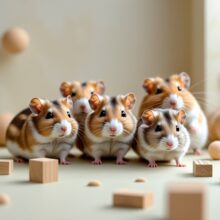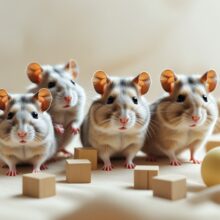DIY Gerbil Toys

DIY Gerbil Toys: Creative and Fun Enrichment Ideas for Your Gerbils
Gerbils are active and curious creatures that thrive on mental and physical stimulation. Providing a variety of toys and enrichment activities is essential for their well-being. While commercial toys are available, creating DIY gerbil toys can be a fun and cost-effective way to keep your pets entertained and engaged. This comprehensive guide will walk you through several DIY gerbil toy ideas, including materials, instructions, and safety tips.
Importance of DIY Gerbil Toys
DIY gerbil toys offer several benefits for both you and your gerbils:
- Cost-Effective: Many DIY toys can be made from materials you already have at home, saving you money on store-bought toys.
- Customizable: DIY toys can be tailored to your gerbils’ preferences and needs, allowing you to create unique and engaging enrichment items.
- Creative Outlet: Making DIY toys is a creative and enjoyable activity that can be a rewarding way to bond with your pets.
Materials for DIY Gerbil Toys
When creating DIY gerbil toys, it’s important to use safe and non-toxic materials. Here are some commonly used materials for DIY gerbil toys:
- Cardboard: Cardboard tubes, boxes, and sheets are versatile and safe for gerbils to chew on.
- Paper: Shredded paper, tissue paper, and paper bags can be used for nesting materials and foraging toys.
- Wood: Natural, untreated wood such as applewood sticks, popsicle sticks, and wooden dowels are great for gnawing and building structures.
- Hay: Hay can be used for stuffing toys and creating tunnels.
- String: Natural fiber string like sisal or jute can be used to create hanging toys and climbing structures.
- Non-Toxic Glue: If glue is needed, use non-toxic glue to ensure the safety of your gerbils.
DIY Gerbil Toy Ideas
- Cardboard Mazes
Cardboard mazes provide mental stimulation and encourage natural foraging behavior. Here’s how to make a simple cardboard maze:
Materials:
- Cardboard boxes
- Scissors or a craft knife
- Non-toxic glue or tape
Instructions:
- Create the Base: Start with a large, flat piece of cardboard as the base of the maze.
- Cut Walls: Cut strips of cardboard to serve as the walls of the maze. Make them tall enough to prevent your gerbil from climbing out.
- Assemble the Maze: Use glue or tape to attach the walls to the base, creating a series of connected paths and dead ends. Make sure to leave entrances and exits.
- Add Enrichment: Place treats or small toys inside the maze to encourage exploration and foraging.
- Hanging Toys
Hanging toys provide opportunities for climbing and gnawing. They can be made from simple materials and hung from the top of the cage.
Materials:
- Sisal or jute string
- Small pieces of wood or cardboard
- Non-toxic glue
Instructions:
- Cut the String: Cut a length of string long enough to hang from the top of the cage.
- Attach Pieces: Thread small pieces of wood or cardboard onto the string, securing them with knots or non-toxic glue.
- Hang the Toy: Attach the toy to the top of the cage, ensuring it is securely fastened and within reach of your gerbil.
- Treat Rolls
Treat rolls are simple foraging toys that encourage natural gnawing and searching behaviors.
Materials:
- Cardboard tubes (from toilet paper or paper towel rolls)
- Hay or shredded paper
- Treats (such as sunflower seeds or small pieces of fruit)
Instructions:
- Stuff the Tube: Fill the cardboard tube with hay or shredded paper and a few treats.
- Seal the Ends: Fold or crimp the ends of the tube to seal the treats inside.
- Place in Cage: Place the treat roll in the cage and watch your gerbil enjoy gnawing and foraging for the hidden treats.
- Digging Box
A digging box provides a designated area for your gerbil to dig and burrow, satisfying their natural instincts.
Materials:
- Shallow container or box
- Dust-free sand or soil
- Small toys or treats (optional)
Instructions:
- Fill the Container: Fill the container or box with dust-free sand or soil.
- Add Enrichment: Bury small toys or treats in the sand to encourage digging.
- Place in Cage: Place the digging box in the cage and allow your gerbil to explore and dig.
- Puzzle Feeders
Puzzle feeders challenge your gerbil to work for their food, providing mental stimulation and preventing boredom.
Materials:
- Small cardboard boxes
- Non-toxic glue
- Treats or food pellets
Instructions:
- Create Compartments: Cut the cardboard boxes into small compartments or sections.
- Assemble the Feeder: Glue the compartments together to create a multi-chambered puzzle feeder.
- Add Food: Place treats or food pellets in each compartment.
- Place in Cage: Place the puzzle feeder in the cage and watch your gerbil figure out how to access the food.
Safety Tips for DIY Gerbil Toys
When creating and using DIY gerbil toys, safety should always be a priority. Here are some important safety tips to keep in mind:
- Avoid Toxic Materials: Ensure that all materials used are non-toxic and safe for gerbils to chew on. Avoid painted or treated wood, as well as plastics that can be easily chewed and ingested.
- Check for Sharp Edges: Inspect toys for any sharp edges or small parts that could cause injury or be swallowed.
- Supervise New Toys: When introducing new toys or enrichment items, supervise your gerbils to ensure they are using them safely.
- Maintain Cleanliness: Regularly clean and replace toys to prevent the buildup of dirt and bacteria. Ensure food-dispensing toys and foraging items are free from mold or spoilage.
Conclusion
Creating DIY gerbil toys is a fun and cost-effective way to provide enrichment and stimulation for your pets. By using safe and non-toxic materials, you can create a variety of engaging toys that cater to your gerbils’ natural behaviors and needs. Whether you choose to make cardboard mazes, hanging toys, treat rolls, digging boxes, or puzzle feeders, the key is to offer a diverse and ever-changing array of activities that keep your gerbils entertained and enriched. With the right toys and environment, your gerbils will thrive and bring joy and companionship to your life.



